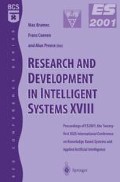Abstract
Strategist is an algorithm for strategic induction of decision trees in which attribute selection is based on the reasoning strategies used by doctors. The advantage is that in problem-solving applications of the induced decision tree, the relevance of an attribute or test can be explained in terms of the strategy it was selected to support, such as confirming a target outcome class or eliminating a competing outcome class. However, it is possible that an alternative approach to attribute selection may produce a decision tree with greater predictive accuracy from a given set of training data. The structure of the decision trees that an algorithm produces may also be an important factor in terms of problem-solving efficiency. We present a new algorithm for strategic induction of decision trees in which Strategist’s multiple-strategy approach to attribute selection is replaced by the single strategy of increasing the probability of a target outcome class. While sharing Strategist’s ability to explain the relevance of attributes in strategic terms, the new algorithm often produces more efficient decision trees than Strategist and matches the accuracy of ID3 on some data sets.
Access this chapter
Tax calculation will be finalised at checkout
Purchases are for personal use only
Preview
Unable to display preview. Download preview PDF.
References
Breslow, L.A., Aha, D.W.: Simplifying Decision Trees: a Survey. Knowledge Engineering Review 12 (1997) 1–40
Leake, D.B.: CBR in Context: the Present and Future. In Leake, D.B. (ed): Case-Based Reasoning: Experiences, Lessons & Future Directions. AAAI Press/MIT Press (1996) 3–30
Southwick, R.W.: Explaining Reasoning: an Overview of Explanation in Knowledge-Based Systems. Knowledge Engineering Review 6 (1991) 1–19
Quinlan, J.R.: Induction of Decision Trees. Machine Learning 1 (1986) 81–106
Breiman, L., Friedman, J.H. Olshen, R.A., Stone, C.J.: Classification and Regression Trees. Pacific Grove, California (1984)
Buntine, W., Niblett, T.: A Further Comparison of Splitting Rules for Decision Tree Induction. Machine Learning 8 (1992) 75–85
Lopez de Mántaras, R.: A Distance-Based Attribute Selection Measure for Decision Tree Induction. Machine Learning 6 (1991) 81–92.
Mingers, J.: An Empirical Comparison of Selection Measures for Decision-Tree Induction. Machine Learning 3 (1989) 319–342
Quinlan, J.R.: C4.5: Programs for Machine Learning. Morgan Kaufmann, San Mateo, California (1993)
McSherry, D.: Strategic Induction of Decision Trees. Knowledge-Based Systems 12 (1999) 269–275
McSherry, D.: A Case Study of Strategic Induction: the Roman Numerals Data Set. In: Bramer, M., Preece, A., Coenen, F. (eds): Research and Development in Intelligent Systems XVII. Springer-Verlag, London (2000) 48–61
McSherry, D.: Interactive Case-Based Reasoning in Sequential Diagnosis. Applied Intelligence 14 (2001) 65–76
Elstein, A.S., Schulman, L.A., Sprafka, S.A.: Medical Problem Solving: an Analysis of Clinical Reasoning. Harvard University Press, Cambridge, Massachusetts (1978)
McSherry, D.: Dynamic and Static Approaches to Clinical Data Mining. Artificial Intelligence in Medicine 16 (1999) 97–115
Shortliffe, E.H. and Barnett, G.O.: Medical Data: Their Acquisition, Storage and Use. In Shortliffe, E.H. and Perreault, L.E. (eds): Medical Informatics: Computer Applications in Health Care. Addison-Wesley, Reading, Massachusetts (1990) 37–69
Mitchell, T.M.: Machine Learning. McGraw-Hill (1997)
Fisher, D.H.: Knowledge Acquisition Via Incremental Conceptual Clustering. Machine Learning 2 (1987) 139–172
Cendrowska, J.: PRISM: an Algorithm for Inducing Modular Rules. International Journal of Man-Machine Studies 27 (1987) 349–370
Blake, C., Merz, C.: UCI Repository of Machine Learning Databases. Department of Information and Computer Science, University of California, Irvine, California (1998)
Aha, D.W.: Editorial: Lazy Learning. Artificial Intelligence Review 11 (1997) 7–10
Aha, D.W.: The Omnipresence of Case-Based Reasoning in Science and Application. Knowledge-Based Systems 11 (1998) 261–273
Aha, D.W., Kibler, D., Albert, M.K.: Instance-Based Learning Algorithms. Machine Learning 6 (1991) 37–66
Friedman, J.H. Kohavi, R. Yun, Y.: Lazy Decision Trees. Proceedings of the Thirteenth National Conference on Artificial Intelligence, 717–724. AAAI Press, Menlo Park, California (1996) 717–724
McSherry D.: Integrating Machine Learning, Problem Solving and Explanation. In: Bramer, M., Nealon, J., Milne, R. (eds): Research and Development in Expert Systems XII. SGES Publications, UK (1995) 145–157
Smyth, B. Cunningham, P.: A Comparison of Incremental Case-based Reasoning and Inductive Learning. In: Haton, J-P., Keane, M., Manago, M. (eds): Advances in Case-Based Reasoning. LNAI, Vol. 984. Springer-Verlag, Berlin Heidelberg (1994) 151–164
Bramer, M.: Automatic Induction of Classification Rules from Examples using N-Prism. In: Bramer, M., Macintosh, A., Coenen, F. (eds): Research and Development in Intelligent Systems XVI. Springer-Verlag, London (2000) 99–121
McSherry, D.: Minimizing Dialog Length in Interactive Case-Based Reasoning. Proceedings of the Seventeenth International Joint Conference on Artificial Intelligence. International Joint Conferences on Artificial Intelligence (2001) 993–998
McSherry, D.: Automated Explanation of Attribute Relevance in Decision-Tree Induction. Technology and Health Care 9 (2001) 34–36
Bohanec, M., Bratko, I.: Trading Accuracy for Simplicity in Decision Trees. Machine Learning 15 (1994) 223–250
Quinlan, J.R.: Simplifying Decision Trees. International Journal of Man-Machine Studies 27 (1987) 221–234
Author information
Authors and Affiliations
Editor information
Editors and Affiliations
Rights and permissions
Copyright information
© 2002 Springer-Verlag London
About this paper
Cite this paper
McSherry, D. (2002). Explanation of Attribute Relevance in Decision-Tree Induction. In: Bramer, M., Coenen, F., Preece, A. (eds) Research and Development in Intelligent Systems XVIII. Springer, London. https://doi.org/10.1007/978-1-4471-0119-2_4
Download citation
DOI: https://doi.org/10.1007/978-1-4471-0119-2_4
Publisher Name: Springer, London
Print ISBN: 978-1-85233-535-9
Online ISBN: 978-1-4471-0119-2
eBook Packages: Springer Book Archive

